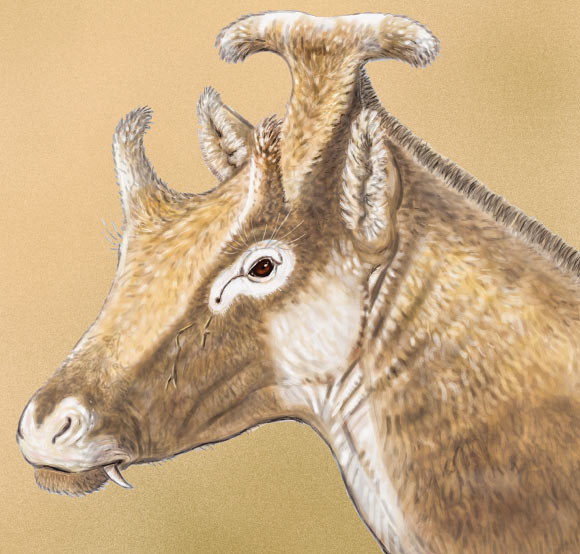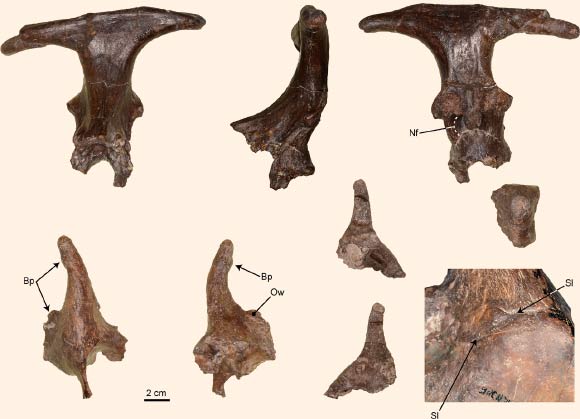Fossil remains of a previously unknown species of palaeomerycid ruminant that lived about 16 million years ago have been found in Spain, paleontologists announced this week.

Life reconstruction of the head of Xenokeryx amidalae; adult male based on the fossils from La Retama. Image credit: Israel Sánchez.
Palaeomerycid ruminants, now extinct, were strange three-horned Eurasian mammals known through fossils from Spain to China.
The first remains of palaeomerycids were originally described on the basis of middle Miocene fossils from Georgensmünd, Germany. Subsequently, such fossils have been found in other parts of Europe and China.
The group is particularly well-known from the middle Miocene of the Iberian Peninsula, displaying a good diversity of forms. Some of these Spanish remains are among the best palaeomerycid specimens described.
A team of German and Spanish paleontologists has now described the beautifully preserved remains of a new palaeomerycid species from the middle Miocene fossil site of La Retama, Cuenca province, Spain.
The team’s leading scientist, Dr Israel Sánchez of the National Museum of Natural History in Madrid, said the new species is called, Xenokeryx amidalae, after a character from Star Wars.
“Referred to the fictional character Padme Amidala from Star Wars, due to the striking resemblance that the occipital appendage of Xenokeryx bears to one of the hairstyles that the aforementioned character shows in The Phantom Menace feature film.”
A detailed description of Xenokeryx amidalae appears in the December 2 online edition of the journal PLoS ONE.

Cranial remains of Xenokeryx amidalae. Abbreviations: Bp – bumps; Nf – nuchal fossa; Ow – ossicone ‘wing’; Sl – suture line between ossicone and frontal bone. Image credit: Israel Sánchez.
Dr Sánchez and his colleagues also explored the phylogenetic relationships among known forms of palaeomerycids to understand their evolution and reassess their systematics.
The paleontologists found that despite their apparent external similarities, Eurasian palaeomerycid ruminants are not closely related to North American dromomerycids (distant relatives of deer), as some scientists have thought.
“We find that Eurasian palaeomerycids are not closely related to North American dromomerycids, thus rejecting the currently more accepted view of palaeomerycids as the Eurasian part of the dromomerycid lineage,” Dr Sánchez and co-authors said.
“Instead of this, palaeomerycids are nested with the African Miocene pecoran Propalaeoryx and with giraffoids.”
“Establishing the place of palaeomerycids in the ruminant tree gives us insights into the evolutionary history of the large clade of pecoran ruminants that include giraffes (Giraffa and Okapia) as its only extant survivors, and shows us the amazing diversity of an ancient lineage that inhabited both Eurasia and Africa,” Dr Sánchez added.
_____
Sánchez IM et al. 2015. Systematics and Evolution of the Miocene Three-Horned Palaeomerycid Ruminants (Mammalia, Cetartiodactyla). PLoS ONE 10 (12): e0143034; doi: 10.1371/journal.pone.0143034







